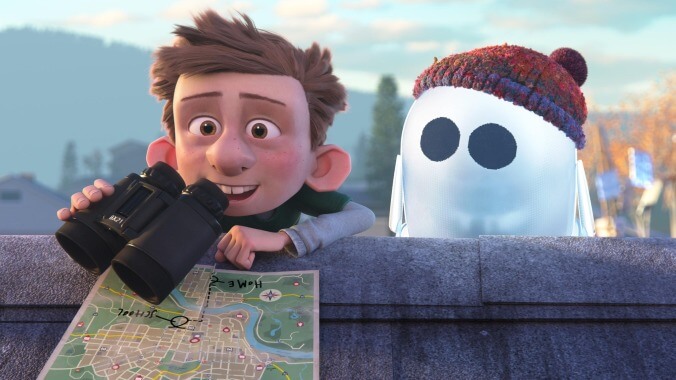The future of friendship is glitchy and goofy in the mixed-up Ron’s Gone Wrong
It’s just not natural to have a robot for a BFF, even if he’s voiced by Zach Galifianakis

For kids, owning toys often acts as a dry run for friendship with fellow human beings. They assign their playthings identities and personalities, and then in the make-believe sessions they share, engaging with the pretend pal forges a meaningful bond that prepares the child for the genuine article. This was the gist of Toy Story, in which old-fashioned Woody the cowboy frets that he’ll be supplanted as primary BFF by the shiny, new, high-tech Buzz Lightyear, an anxiety to which any elementary-schooler can relate. The new animated feature Ron’s Gone Wrong downloads a digital-age patch for the concept, as awkward young Barney (Jack Dylan Grazer) finds a companion in the buggy-but-lovable robot Ron (Zach Galifianakis). From possession to pet to peer, the hijink-prone A.I. teaches our boy the patience and empathy required to bust through the dreaded recess-yard ostracizing.
But because the chronically on-the-fritz Ron is less trinket than computerized smart-gadget, his presence in the film comes with a heap of baggage that writer-director Sarah Smith, co-directors Jean-Philippe Vine and Octavio E. Rodriguez, and co-writer Peter Baynham seem eager to unpack.. As in the curiously similar The Mitchells Vs. The Machines, the misadventures transmit a lighthearted commentary on the wonders and hazards of our screen-saturated culture. In this instance, however, there’s a system incompatibility error with the dominant bestie metaphor that leaves the film’s stance on Big Gizmo garbled. As the script would have it, we’ve got to keep an eye on those pesky, surveillance-enabling, Asimov’s law-breaking mini-droids. But when they double as stand-ins for outcasts deserving of love, we’re also expected to respect their glitches and let them malfunction in peace. That’s what having a friend is all about. Or something. It gets kind of hard to tell.
Barney starts out as the only one at school without a “B-bot” by his side, though he’s not from a family of Luddites or anything. His dorky dad (Ed Helms) and often hilarious post-Eastern Bloc grandmother (Olivia Colman) want the best for him. It’s just that their lower-middle-class income makes it tough to have the latest, hottest must-buy. That detail of class hints at the first in a series of delicate social dynamics teased out by the arrival of Ron, purchased on the cheap after the unit tumbles off a truck and takes some light damage. At first, the little guy and Barney make a natural pair in their difficulty fitting in, Ron’s slightly compromised hardware turning him hyper-literal and fixated on things starting with the letter A. In time, they’ll find that his imperfections make him special—that what amounts to being jailbroken also allows him to have more unpredictable fun.
Slow to pick up on interpersonal cues everyone else understands as second nature, Ron shares a few common traits with individuals with autism, casting Barney’s effort to help the automaton behave like a real boy in a more poignant (if possibly problematic) light. The intended takeaway in their connection—that true closeness means embracing one another’s differences instead of ironing them out—plays out legibly in this context. But in their zippy, kinetic escapades marking this as energetic kiddie entertainment, a spirit of empathy grinds against the healthy skepticism towards tech giants.
The “B-bot” comes in the reflective white plastic of an Apple product, manufactured by the soundalike mega-start-up Bubble. The company is run by an overtly evil guy styled to resemble Tim Cook (Rob Delaney) and a more idealistic, compassionate code-head (Justice Smith), their contrast a tidy summary of the film’s own ambivalence. In some scenes, the internet of things may be a ticking time-bomb with massive potential to warp juvenile psychologies and even do bodily harm. In others, seems like everything would be fine if we simply programmed, uh, better. The hasty fix-up to a second-act turn in which the B-bots go rogue requires a reformed Bubble to clean up its own mess; the credulousness of that resolution is severely out of joint with the valid points the film has raised.
A conclusion that sees Bubble’s newly instated good-guy CEO announcing “Welcome to the future of friendship!” and the world’s youth coexisting with even more chaotic, independently willful robots denies the dystopian ring that this scenario has on paper. Much of that is due to the steadily buoyant mood, admirable quotient of good jokes, and antic sensibility in sync with the ebullient aesthetic last seen in Smith’s Arthur Christmas. It also goes back to the sincerity of the camaraderie between the two kindred souls in the leading roles, their affection powerful enough to overcome anything, so strong it overtakes cogent articulation of the film’s theme.